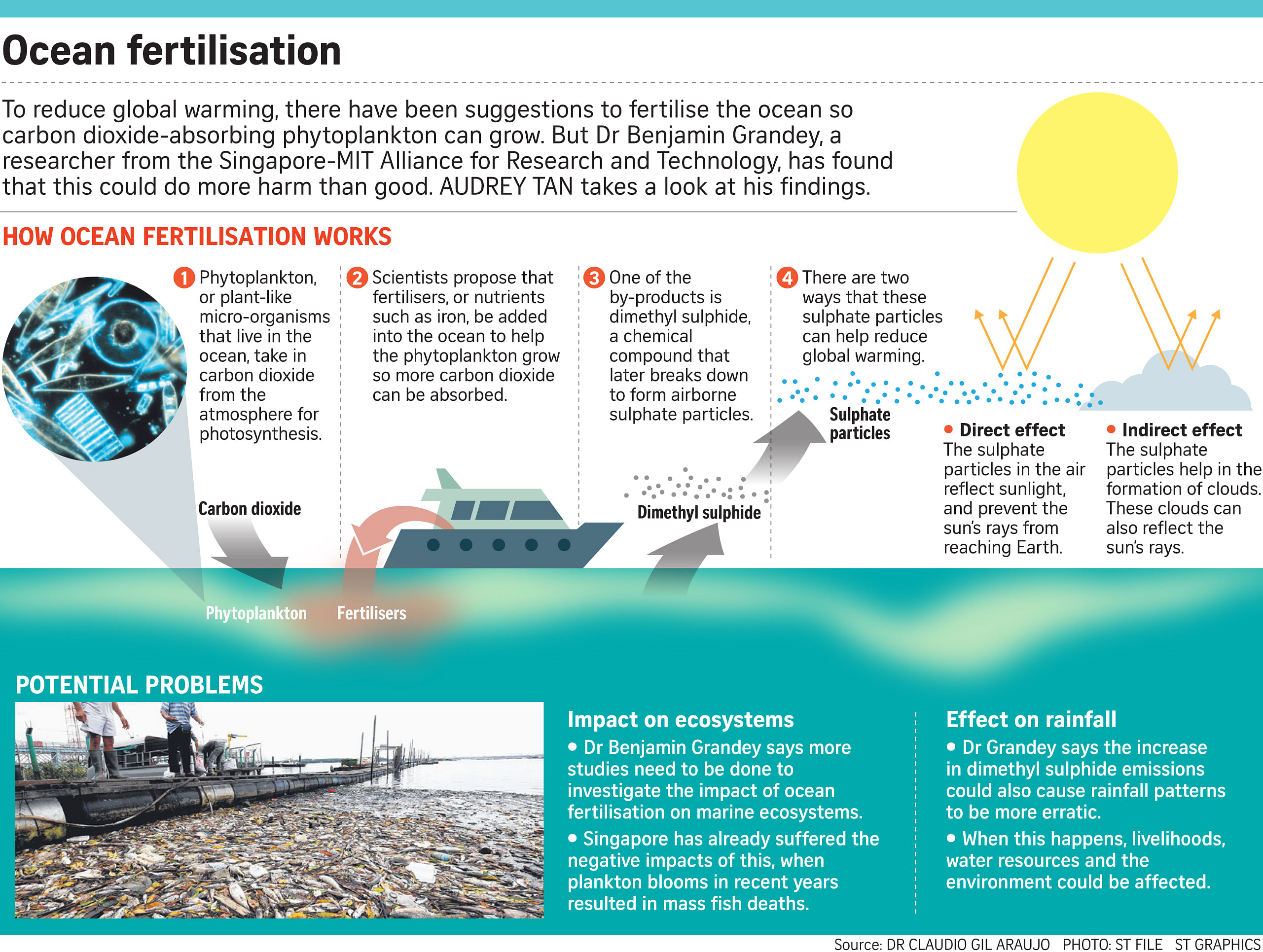Shivers over growing plankton to cool earth
While some scientists believe the plant-like micro-organisms can help to combat global warming, others say they could do more harm than good
Sign up now: Get ST's newsletters delivered to your inbox

Dr Benjamin Grandey (left) and Dr Chien Wang have shown, using modelling methods, that while ocean fertilisation could prevent the global mean surface temperature from rising beyond 2 deg C this century, it could also lead to erratic rainfall patterns. This would hurt agricultural countries reliant on rain for growing crops.
ST PHOTO: DESMOND FOO
Follow topic:
Fertilising the seas to create a plankton bloom may sound like a bad idea, as these mounds of microalgae have caused mass fish deaths in Singapore and around the world.
But some scientists believe it will help reduce carbon dioxide, a greenhouse gas, and combat global warming.
Growing more phytoplankton will mean that the plant-like microorganisms that live in water can remove more heat-trapping carbon dioxide from the atmosphere during photosynthesis.
On top of that, a sulphur-containing by-product from this reaction may also induce cooling by reducing the amount of the sun's heat that reaches earth.

But Dr Benjamin Grandey and Dr Chien Wang, from the Centre for Environmental Sensing and Modeling at the Singapore-MIT Alliance for Research and Technology, have proved why this is indeed a bad idea.
-
National green pledges still not ideal
National pledges to cut greenhouse gas emissions, even if fully implemented, would cap global warming at 3 deg C, rather than the 2 deg C that has been targeted to avoid dangerous consequences, says the European Commission.
These pledges, or Intended Nationally Determined Contributions (INDC), summarise each country's intent to reduce emissions of greenhouse gases ahead of the pivotal climate change talks in Paris in December.
The goal is to develop an agreement for the post-2020 period that would help keep global temperatures from rising more than 2 deg C above pre-Industrial Revolution levels.
Singapore's INDC, submitted in July, sets out its plans to cap greenhouse gas emissions to about 65 million tonnes by around 2030, and to stop any more increases.
The Republic has also pledged to become greener economically by reducing the amount of greenhouse gases emitted to achieve each dollar of gross domestic product - by more than a third.
Audrey Tan
Using a model that takes into account factors such as rainfall, temperatures and wind patterns, they showed that while ocean fertilisation could prevent the global mean surface temperature from rising beyond 2 deg C this century, it could also lead to erratic rainfall patterns.
This would have a drastic impact on the water cycle, the environment and human livelihoods - especially in agricultural countries.
"The harm that this geoengineering (climate engineering) method could cause outweighs the benefits," Dr Grandey told The Straits Times.
One by-product of ocean fertilisation is a chemical compound known as dimethyl sulphide, which breaks down to form airborne sulphate particles.
These sulphate particles can cause cooling in two ways.
First, the sulphate particles, each measuring less than one micron (a millionth of a metre) in diameter, could reflect the sun's rays away from earth and prevent them from reaching the ground.
Second, when water vapour condenses on the sulphate particles, clouds are formed, which also prevent the sun's rays from heating up the ground.
But Dr Grandey's research showed that the greater cloud cover would not mean more rain. The model showed, in fact, that with more dimethyl sulphide emissions associated with ocean fertilisation, most of the world would experience less rainfall.
"Reductions in precipitation (rainfall) over Europe, the Horn of Africa and Pakistan may have an adverse impact on the environment and human livelihoods," Dr Grandey noted in the paper, which was published recently in science journal Nature's Scientific Reports.
Aside from erratic rainfall, Dr Grandey also pointed out that more studies have to be done to find out the impact of ocean fertilisation on marine ecosystems.
After a bloom, phytoplankton die and decompose. The decomposition process uses up dissolved oxygen in the water, causing fish to suffocate. The bloom can also block out sunlight and prevent it from reaching plants on the seafloor.
Earlier this year, a plankton bloom affected 75 fish farms in the East and West Johor Strait, resulting in mass fish deaths in Singapore. About 500 to 600 tonnes of fish died.
Negative effects aside, Dr Grandey added that fertilising the sea would be an unreliable way to delay temperature increases.
"The world needs to do a lot more to cut greenhouse gas emissions," he said. "We can all make a meaningful difference through our everyday choices. We can buy Forest Stewardship Council-certified paper products to reduce deforestation, drive less, and eat less beef."
But Dr Patrick Martin, a research fellow from the Nanyang Technological University's Earth Observatory of Singapore, who has studied the effects of ocean fertilisation using iron, pointed out that a "full-blown iron fertilisation geoengineering programme would realistically cover only a small area of the world's oceans".
"The increase in dimethyl sulphide across the globe modelled by Grandey and Wang would thus not happen," he added.
"Overall, I wouldn't say this study shows iron fertilisation won't work to combat climate change, but I fully agree with the authors that the effects of climate-active trace gases (gases that have an impact on climate), such as dimethyl sulphide, could be important and must be considered."

